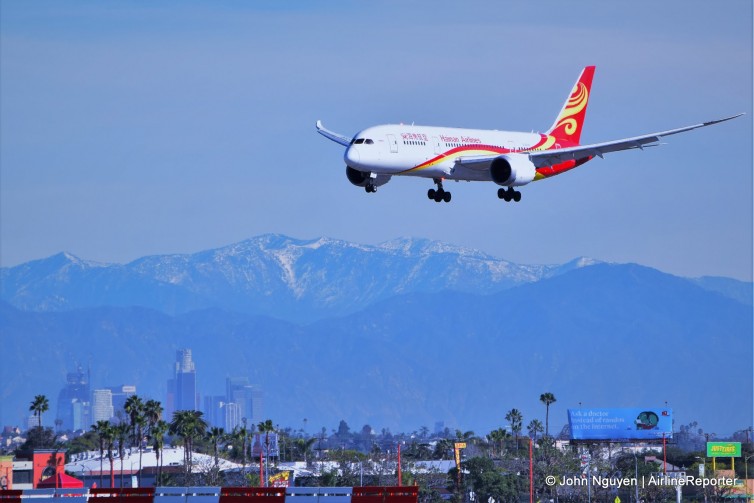
Hainan Airlines’ inaugural flight, operated by a Boeing 787-8 (B-2739), from Changsha to Los Angeles on final approach.
Hainan Airlines, the largest privately operated carrier in China, commenced Los Angeles’s newest non-stop service to the Chinese mainland on January 21. The twice-weekly flights, operated by a Boeing 787-8 Dreamliner, will connect LAX to the capital of Hunan province, Changsha (CSX). AirlineReporter was invited to be on the ramp at LAX for the arrival of the inaugural flight from CSX.
A Background on Hainan Airlines
Hainan Airlines (æµ·å—航空公å¸) is the fourth-largest airline in China, behind state-controlled Air China, China Eastern Airlines, and China Southern Airlines. Based on the southern island of Hainan, the carrier is well-known within China and has built up a strong reputation globally as well, earning the distinction of being one of only six Skytrax “Five-Star”-rated airlines, sharing the honor with global heavyweights such as Cathay Pacific, Qatar Airways, and Singapore Airlines.
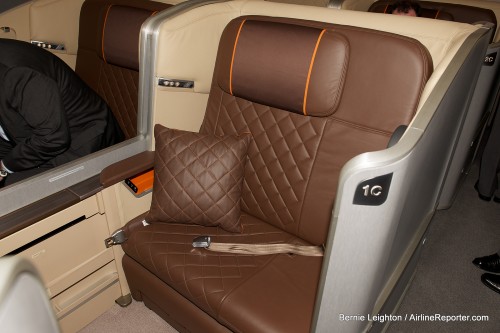
The new First Class seat for Singapore.
While the carrier serves the Chicago O’Hare-to-Beijing route, Hainan’s current overall strategy seems to be connecting the large gateways in China to smaller markets in the U.S. The airline currently flies between:
- Boston to Beijing and Shanghai
- San Jose to Beijing
- Seattle to Beijing and Shanghai
- (Additionally, Toronto to Beijing)
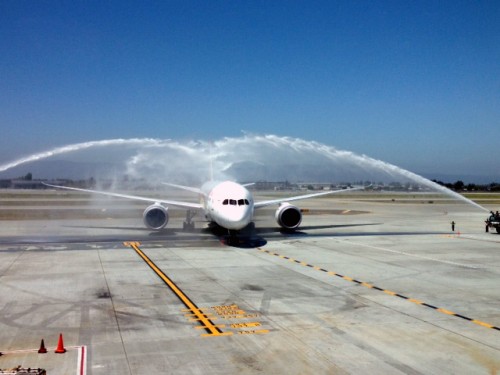
Welcoming water cannon salute for a Hainan 787 on the inaugural flight from Beijing to San Jose – Photo: Michael Restivo | AirlineReporter
Read More: Hainan Airlines Celebrates Inaugural Services in Seattle and San Jose
Already boasting a fleet of over 150, Hainan is quickly modernizing its long-haul operations with dozens of Boeing 787 Dreamliners, having ten 787-8s already in service and another 30 787-9s on order. The super-efficient 787 enables the carrier to fly to far-off secondary destinations and support its expansion plans. All flights to the US are operated by 787s.
With the Los Angeles area having an estimated Chinese American population of 400,000, along with the possible connections from other areas (including nearly 1.35 million in California alone), LAX is a high priority for any carrier to connect to China. However, a Chinese government mandate allows only one Chinese carrier to operate each international route from China, and nonstop service between LAX and the largest cities in China are already served by the “Big Three” Chinese carriers: Air China to Beijing; China Eastern to Shanghai; and China Southern to Guangzhou.
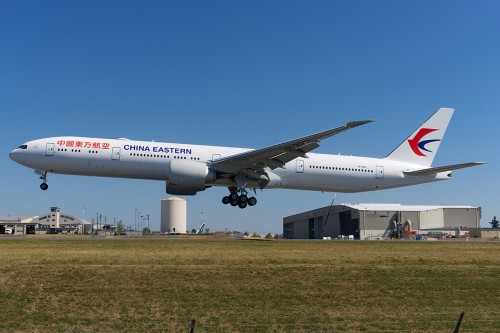
A brand spanking new Boeing 777-300ER at Paine Field showing China Eastern’s new livery. Photo: Bernie Leighton | AirlineReporter
With Hainan effectively blocked from commencing service from LAX to any of the major gateways in China, it chose to invert its typical strategy, connecting a major American gateway to a smaller Chinese market. Hainan’s new service between LAX and Changsha is the first nonstop flight from the U.S. into a “Tier II” city in China. Changsha is the 19th largest city in China and has a population of 7 million. Hainan serves 15 domestic destinations nonstop from Changsha.
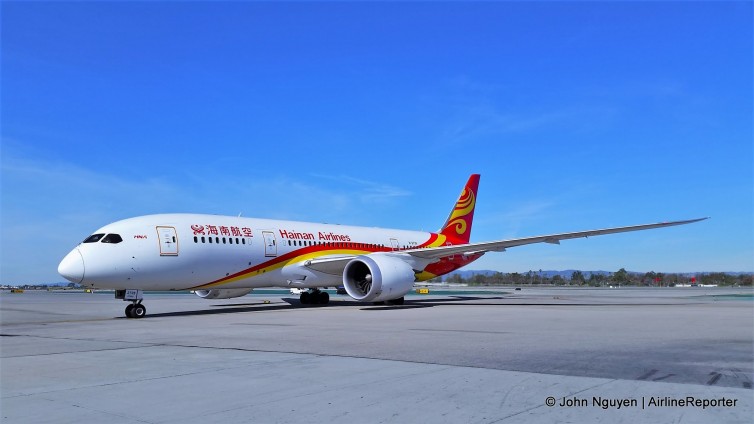
Hainan’s Boeing 787-8 (B-2739) taxiing to the gate at LAX.
In the United States, Hainan has codeshare agreements with Alaska Airlines, American Airlines, Hawaiian Airlines, Jetblue Airways, and Virgin America, with a full reciprocal frequent flyer partnership with Alaska, which is based in Seattle and considers Los Angeles a focus city.
LAX to Changsha: Ground and In-Flight Service

Economy seating on Hainan’s 787. Photo: Hainan Airlines
Hainan’s 787-8s are outfitted with 213 total seats – 36 in business class and 177 in economy. For all passengers, inflight entertainment with large touchscreens is offered as well as in-seat power. Special programming, activities, and meals are available for children. The economy cabin is configured with 9-abreast (3-3-3) seating and 32 inches of pitch.
In business class, the fully 180-degree flat seats are arranged in a 2-2-2 configuration and feature 74 inches of pitch and a 15-inch video screen. Onboard amenities include dine on demand, amenity kits with Bulgari products, pajamas, silk duvet and mattress pad sets for turn-down service, tea service, and an espresso machine. On the ground, Hainan offers private chauffeured car service to and from the airport in both China and the U.S., within a 30-mile radius.

Business class seats on Hainan’s 787. Photo: Hainan Airlines
At LAX, Hainan operates out of Terminal 2 (T2), and not out of the Tom Bradley International Terminal (TBIT) that most international carriers use. While T2 does not have the same level of amenities as TBIT, it is a smaller, recently-renovated terminal with the advantage of being less busy and not as crowded with passengers, especially at the security checkpoint. Also, for those pressed for time to catch their flight, T2 is positioned closer to the roadway entrance at LAX, whereas TBIT is on the far end of the terminal area and can take 20-30 additional minutes to reach in heavy traffic.
The check-in counters at T2 are shared, and on the day of the inaugural flight, Hainan utilized the counters typically occupied by Virgin Atlantic. Flight HU7924 operates twice a week on Thursdays and Sundays, with a scheduled departure of 12:35pm. The check-in counter for Hainan is open at 9:00am on the days with departures and closes approximately 30 minutes prior to departure; because the counters are shared, outside those times there is no signage of Hainan operations in that area.
- Hainan Airlines operates out of Terminal 2 at LAX.
- Staff prepare the check-in area for Hainan’s inaugural flight from LAX to Changsha on January 21.
- Staff prepare the check-in area for Hainan’s inaugural flight from LAX to Changsha on January 21. Business class passengers have a clearly designated queue.
Premium and economy lines are clearly marked at check-in. On the inaugural flight from LAX to Changsha, there were approximately 120 revenue passengers booked, including three or four business class passengers. On this special day, the staff welcomed the first passengers in line, some of whom arrived as early as 8:00am with the misunderstanding that Hainan had round-the-clock operations at LAX. Mr. Joel Chusid, the Executive Director for Hainan’s USA operation, spoke a few words to mark the occasion and shook the hand of the first passenger to check in.
- Joel Chusid, Executive Director for Hainan’s USA operations, welcomes the first passenger to check in for inaugural flight HU7924 from LAX to Changsha on January 21.
- Changsha, the destination of Hainan’s newest flight out of LAX, is so new that the airport’s departure board doesn’t have it in the system. Also off is the departure time listed for HU7924.
Hainan offers premium passengers access to the Air Canada Maple Leaf Lounge. Apart from Air Canada and other Star Alliance airlines, Qatar Airways also uses the lounge, recently having started its own new service out of LAX to Doha. According to lounge manager James Serrano, a few updates are due for the space later this year, especially around the food service area. The lounge is open and airy, with some of the best views of flight operations anywhere at the airport – something Mr. Serrano was particularly proud of.
- The entrance to the Air Canada Maple Leaf Lounge, located on the upper floor in LAX Terminal 2.
- The reception desk inside the Air Canada Maple Leaf Lounge in LAX Terminal 2.
- The view from the Air Canada Maple Leaf Lounge in LAX Terminal 2.
- The self-serve buffet counter inside the Air Canada Maple Leaf Lounge in LAX Terminal 2.
- The self-serve bar inside the Air Canada Maple Leaf Lounge in LAX Terminal 2.
LAX invested up to $300 million to improve Terminal 2 itself, and renovations will continue through 2017. The improvements showed, with wide open, sunlit spaces and plenty of eateries and retail shops available.
- The concourse at LAX Terminal 2.
- The overhead view of LAX’s Terminal 2.
LAX to Changsha: The Inaugural Festivities
Down in the departure lounge, Gate 22 was used for the inaugural ceremony and departure. The area is actually for both Gate 22 (a jetbridge) and Gate 22A (a bus gate), so there was plenty of room for the event as well as passengers who were on the flight. LAX and Hainan personnel were still setting up the area while we waited for the arrival of Flight HU7923 from Changsha.
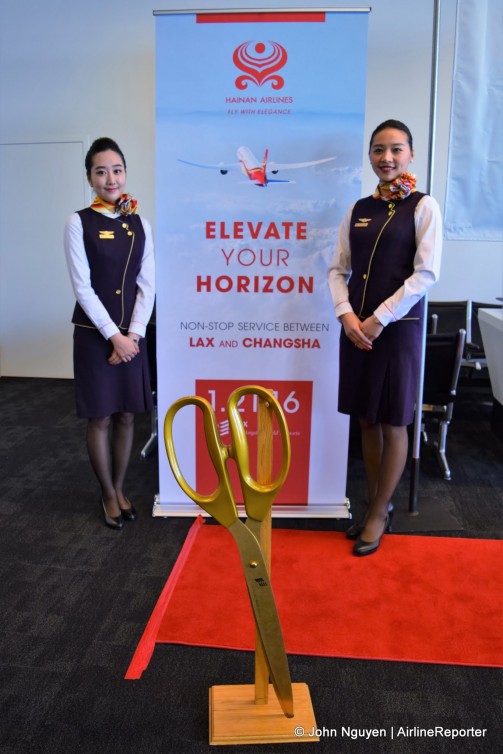
Hainan flight attendants welcome guests to the inaugural flight of HU7924 from LAX to Changsha on January 21.
An interesting note: the cabin crew on hand to greet passengers was wearing different uniforms than what was featured in our previous coverage of the inaugural flights to San Jose and Seattle, as well as on Hainan’s own website. According to Mr. Chusid, the carrier has seasonal uniform changes, with “a lighter weight, light grey uniform in summer and a heavier weight, more formal burgundy uniform (with coats and hats) in winter.” A very nice, elegant touch to Hainan’s brand image, indeed.
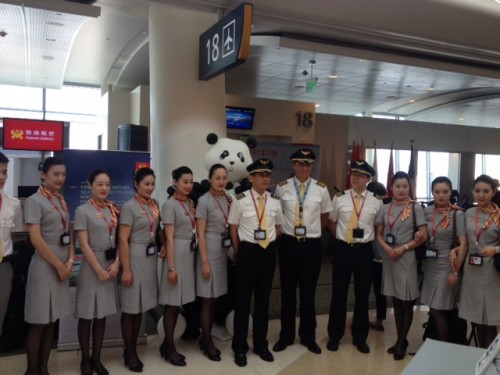
A photo from Hainan’s inaugural flight from San Jose to Beijing in June 2015. Note the summertime uniforms. Photo: Michael Restiva | AirlineReporter
Soon we were escorted outside via the Gate 22A stairs down to the ramp, and we made the short walk to the intersection with Taxiway D to wait for the arrival of the 787, registration no. B-2739. It was a great vantage point to see all the activity in the northern airfield.
Not a bad vantage point for the arrival of HU7923 @flyLAXairport pic.twitter.com/URHp5l3Y31
— Airline Reporter (@AirlineReporter) January 21, 2016
Just after 10:45am, we were given a heads up that HU7923 was on final approach. We had a great view, with Downtown L.A. in the background; luckily the arrival came during a gap in ground traffic, and we had a clear view of B-2739’s landing.
- Hainan’s inaugural flight, operated by a Boeing 787-8 (B-2739), from Changsha to Los Angeles on final approach.
- A Hainan Boeing 787-8 (B-2739), operating inaugural flight HU7923, arrives at LAX.
- A Hainan Boeing 787-8 (B-2739), operating inaugural flight HU7923, touches down on Runway 24R at LAX.
Hainan certainly has one of the most eye-catching liveries on a 787. Unfortunately, no water cannon salute today, due to California’s severe and ongoing drought; in fact, no fire trucks at all, unlike the inaugural flight for Ethiopian Airlines, where the fire department welcomed that flight arriving from Dublin with just lights-and-sirens.
- A Hainan Boeing 787-8 (B-2739), operating inaugural flight HU7923, taxis to the gate at LAX.
- A Hainan Boeing 787-8 (B-2739), operating inaugural flight HU7923, taxis to the gate at LAX.
- A Hainan Boeing 787-8 (B-2739), operating inaugural flight HU7923, arrives at Gate 22 at LAX.
After the 787 docked with the jetbridge, we headed back up to the departure lounge to wait for some passengers off the inbound flight to be processed by customs and immigration, including Mr. Mu Weigang, the Vice Chairman of Hainan Airlines, who traveled from Hainan’s base in Haikou to be part of this occasion.
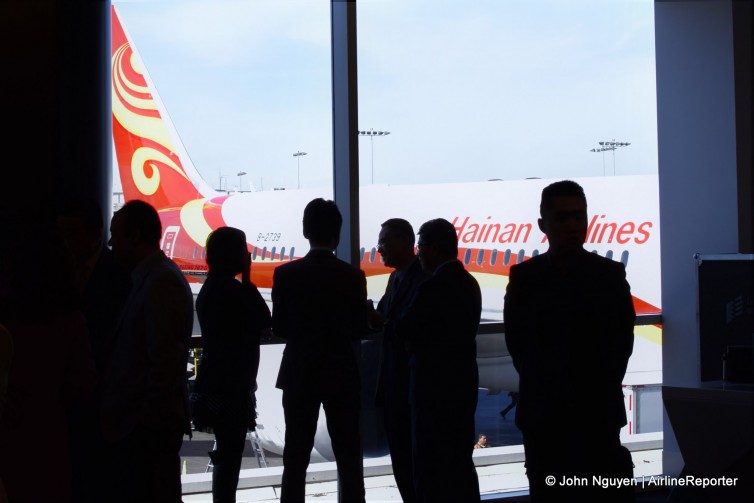
Guests and dignitaries at LAX view Hainan’s Boeing 787-8, which has just arrived from Changsha on inaugural flight HU7923.
In the meantime, Hainan had a full h’ors d’oeuvres spread out, though the selections were decidedly (and somewhat unexpectedly) very un-Chinese: crostini with chicken salad, egg salad, tuna salad, Italian cold-cuts, and ham/cheese, as well as tuna rolls and a couple of large sheet cakes.
Finally, the VIPs arrived and Mr. Chusid started the event with a few words, introducing Hainan Airlines to those who were unfamiliar with the brand. He made light of the airlines relative obscurity stating, “Hainan Airlines is not as well-known as our ‘golden siblings,'” referring to the other state-operated Chinese carriers, “but we’re more youthful and agile,” further noting that Hainan was founded in 1993, and commenced service to North America in 2008. Mr. Chusid also referenced the long amount of time it took for his airline to get into LAX, thanking Los Angeles World Airports (LAWA) and the Chinese National Tourism Board for their efforts.
Marking the significance of the flight, a few other dignitaries also spoke at the event, including the Chinese Consul General for Los Angeles, the deputy executive director of administration for LAWA, the director of the China National Tourism Office in Los Angeles, and a representative from the Los Angeles mayor’s office.
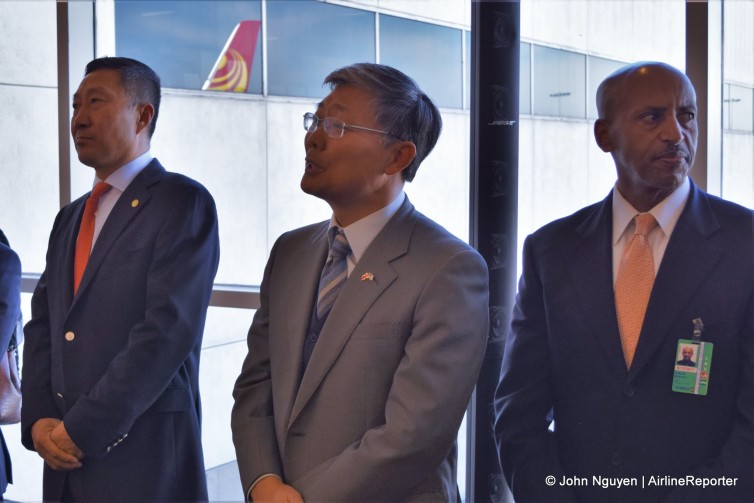
VIPs attend the inaugural event for Flight HU7924 from LAX to Changsha on January 21. From L-R: Mu Weigang, Vice Chairman of Hainan Airlines; Liu Jian, Consul General for China in Los Angeles; and Samson Mengistu, a Deputy Executive Director for LAWA.
The Consul General, Mr. Liu Jian, remarked how 2016 is the “Year of China-U.S. Tourism” as declared by President Xi Jinping, and that in 2015, 780,000 Chinese citizens visited Los Angeles, making China the second-largest inbound tourism market for the city. Mr. Liu also stated that Hainan’s new service from LAX to a Tier II city marks an important milestone in developing the trade and tourism relationship between the two countries.
Previously in Seattle at Hainan’s inaugural ceremony for its flight to Shanghai, the Port of Seattle estimated that each new flight from China represents $75 million of additional economy activity annually to the region. Extrapolating data from LAWA, each additional daily flight to Los Angeles would bring in an additional $600 million of annual economic activity to Southern California.
Mr. Mu then took to the podium to share his thoughts on his company’s achievement in accessing the Los Angeles market. Through his interpreter, he shared how he visited Los Angeles 20 years ago, and since then has had the personal desire to bring his airline to LAX. To paraphrase: mission accomplished.
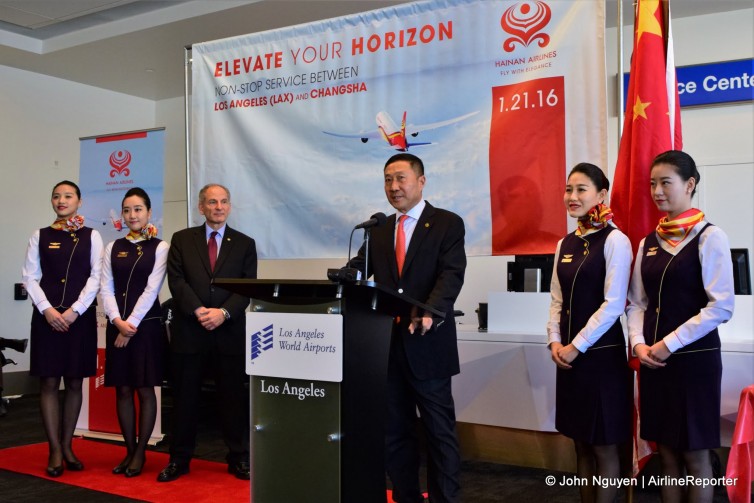
Hou Wei, VP of Hainan Airlines, speaks at the inaugural event for Flight HU7924 from LAX to Changsha on January 21.
The ceremony wrapped up with a presentation of a certificate from the mayor’s office, a ribbon cutting (essential for any inaugural event), and cake cutting.
- A certificate of congratulations from the Los Angeles Mayor’s Office, to commemorate Hainan’s new service from LAX to Changsha.
- Cutting the ribbon at the inaugural event for Flight HU7924 from LAX to Changsha on January 21.
- Cutting the cake at the inaugural event for Flight HU7924 from LAX to Changsha on January 21.
With the delayed arrival of Mr. Mu and other VIPs from the inbound flight, boarding for HU7924 was pushed back and the flight departed approximately one hour late, but still arrived in Changsha ahead of its scheduled 7:20pm arrival time.
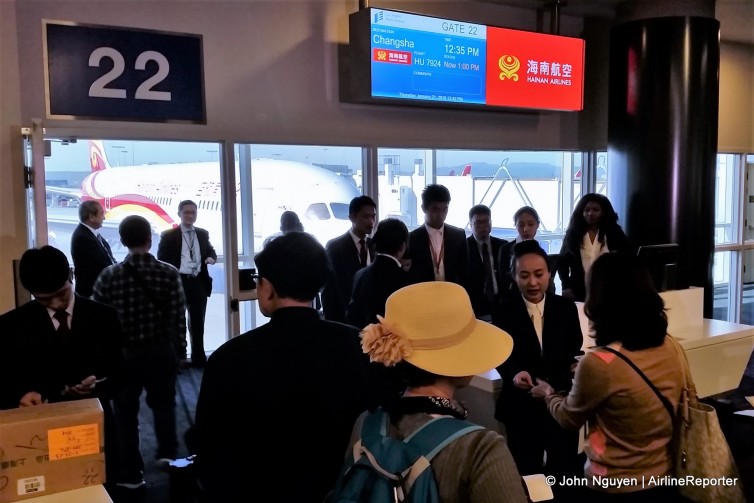
Passengers boarding Hainan’s inaugural flight from LAX to Changsha on January 21.
With the relentless demand for air travel in China unaffected by the downturn of the Chinese economy, Hainan’s investment in international expansion, supported by efficient, modern aircraft and an enhanced passenger experience, is surely a recipe for success.
Update: An earlier version of this story misidentified Mr. Hou Wei, Vice President of Hainan Airlines, as the airlines’ executive in attendance. Due to a last-minute change, Mr. Hou was not able to travel to Los Angeles. Mr. Mu Weigang, Vice Chairman of Hainan Airlines, attended the ceremony instead.

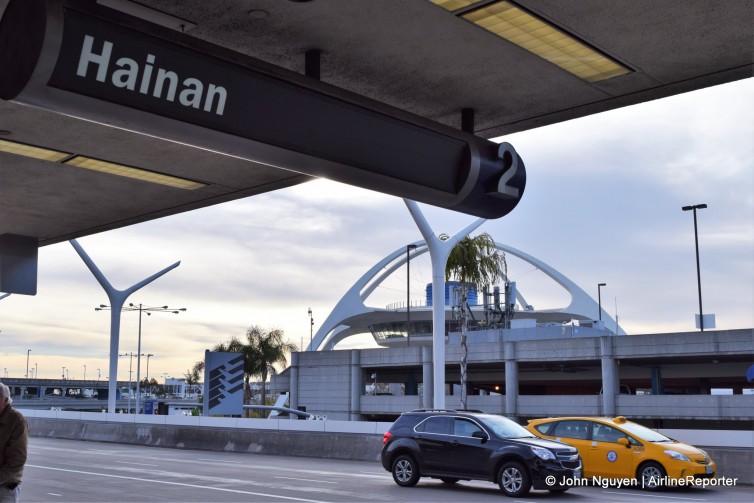
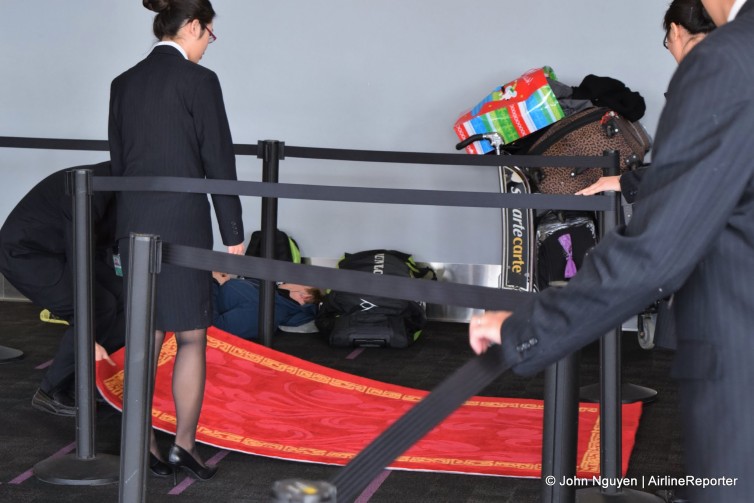
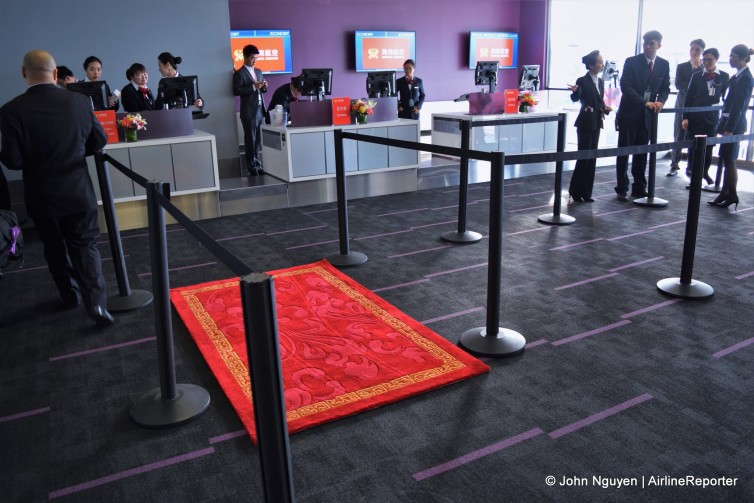
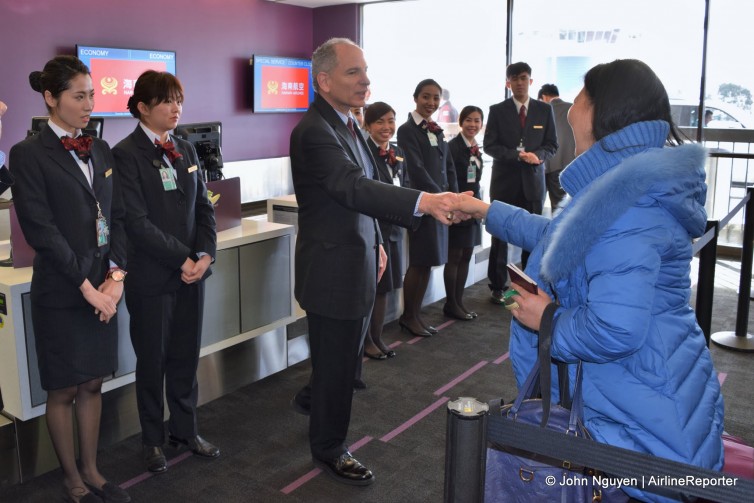
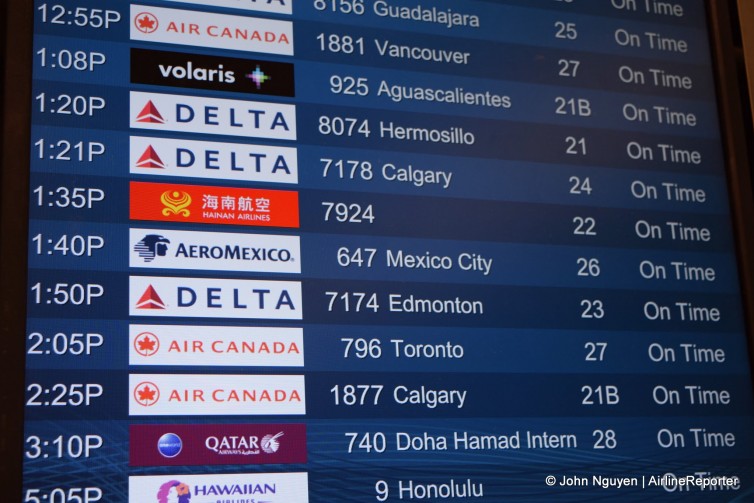
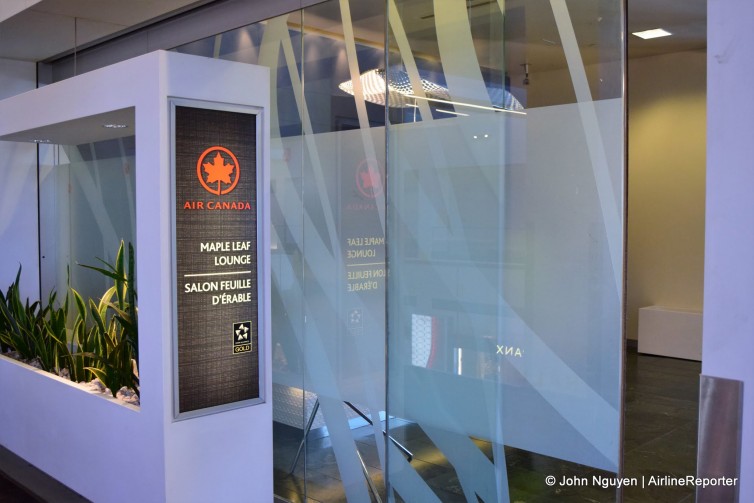
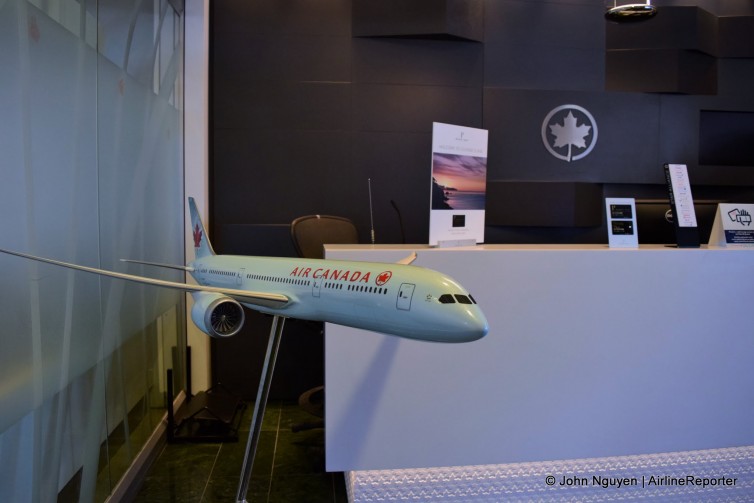
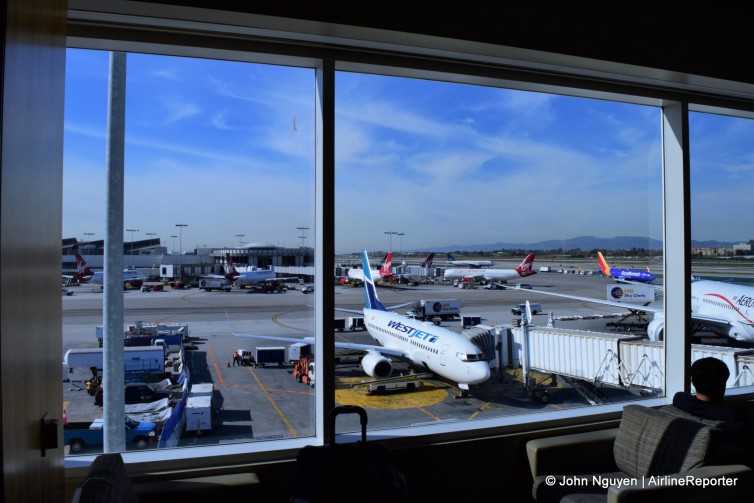
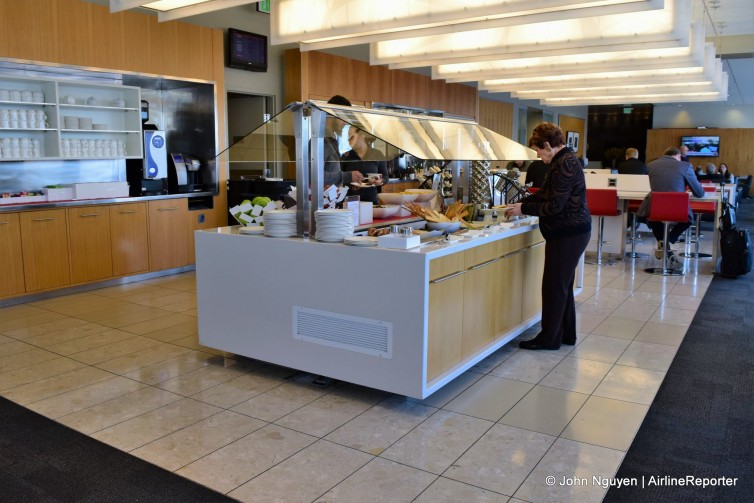
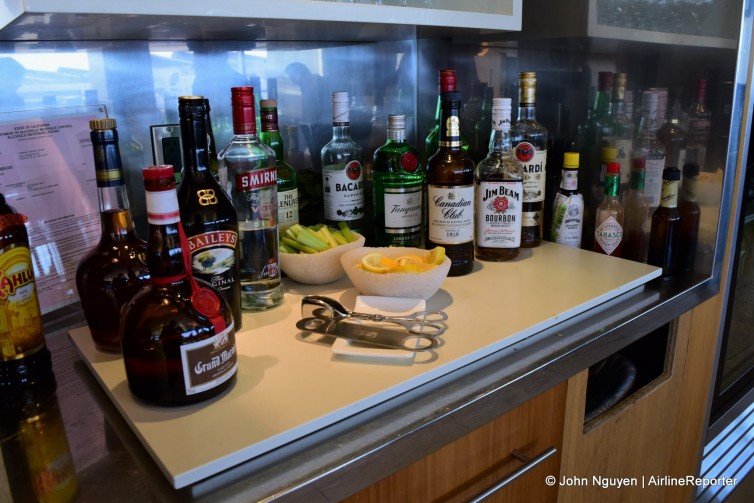
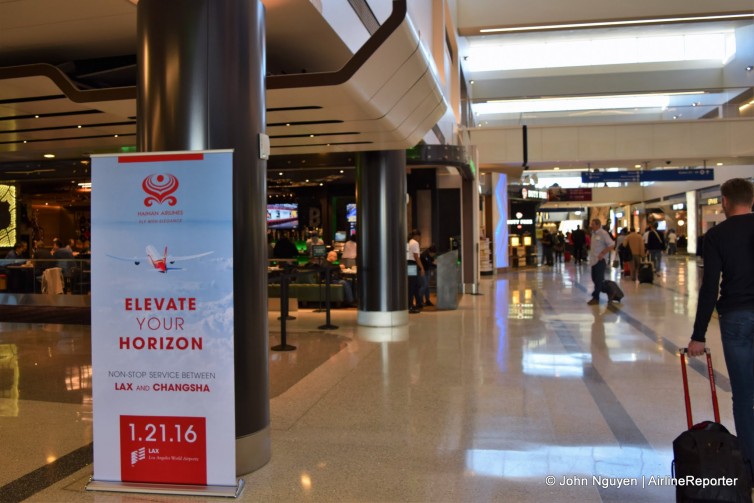
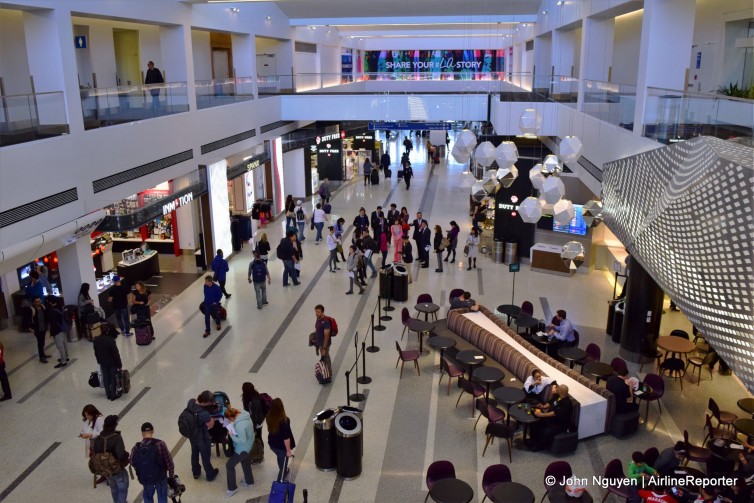
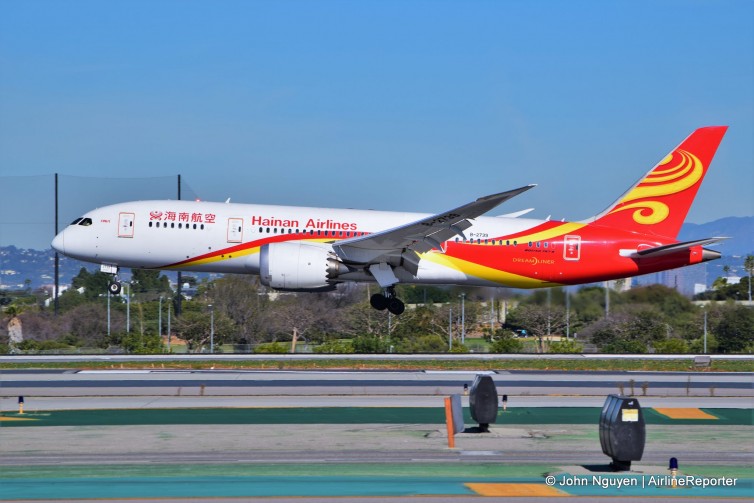
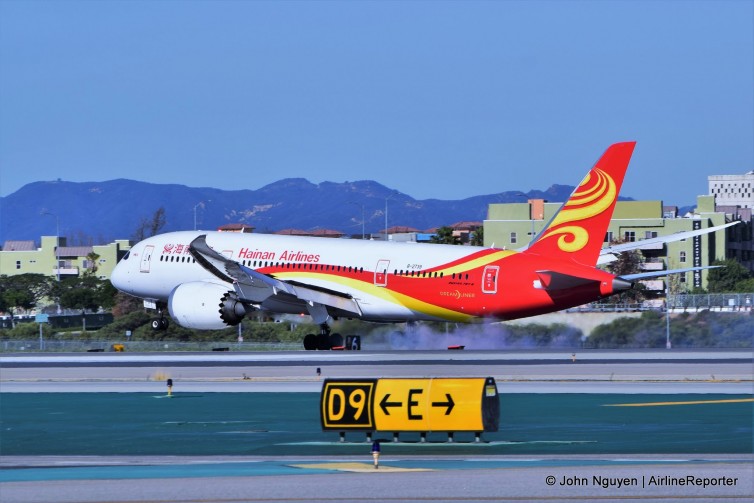
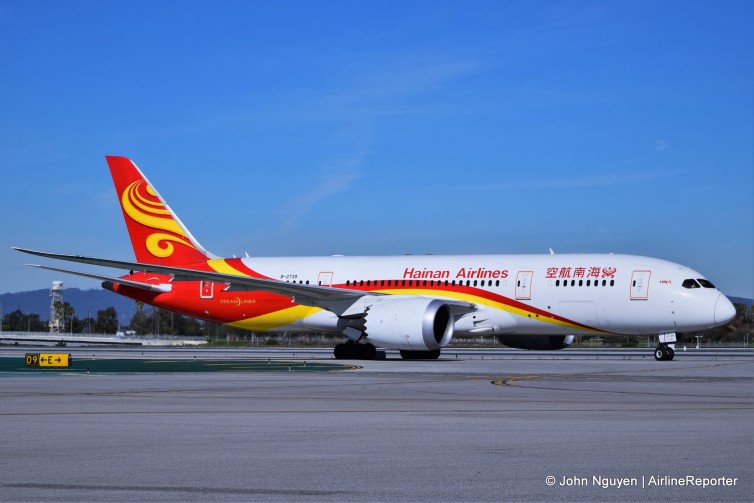
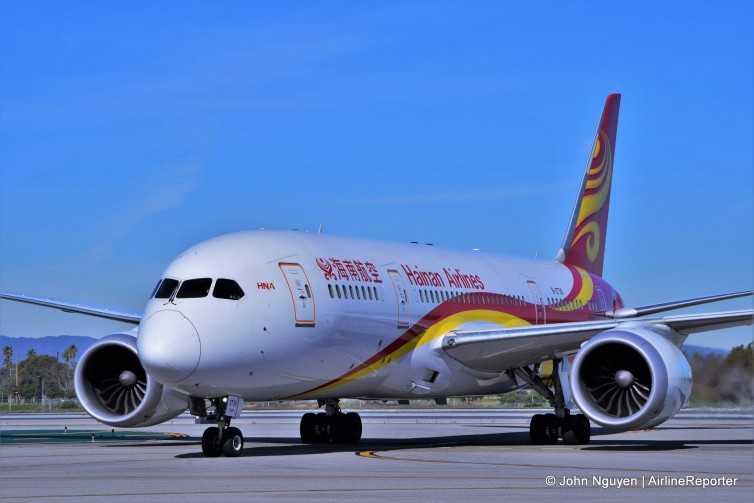
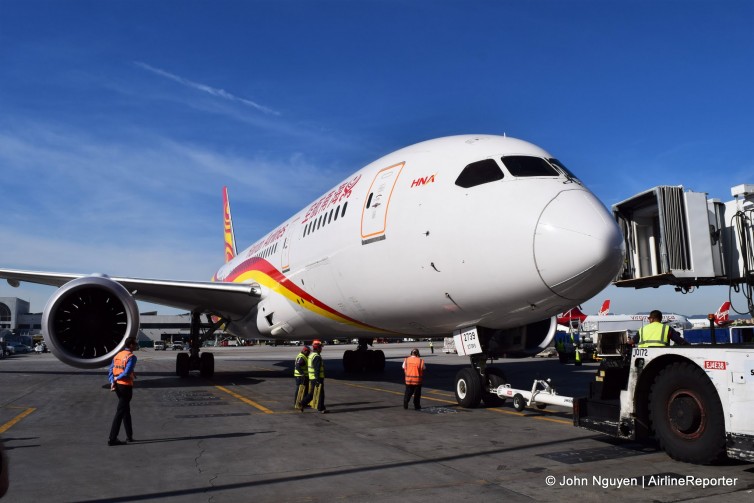
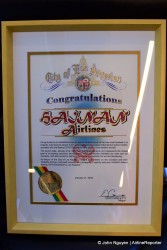
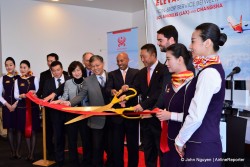
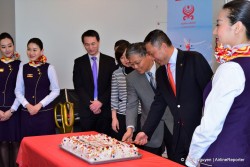
Great post! Have nice day ! 🙂 mkzzg